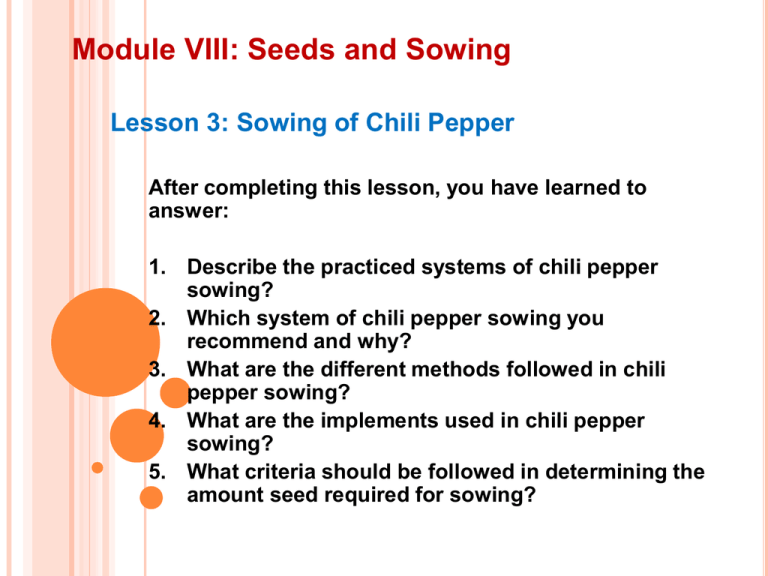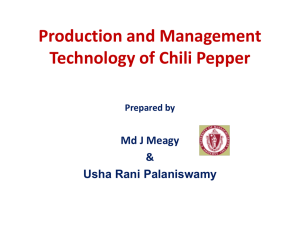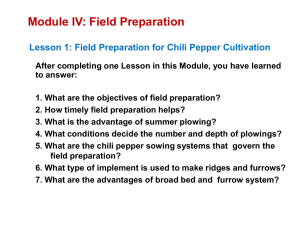Module VIII: Seeds and Sowing
advertisement

Module VIII: Seeds and Sowing Lesson 3: Sowing of Chili Pepper After completing this lesson, you have learned to answer: 1. Describe the practiced systems of chili pepper sowing? 2. Which system of chili pepper sowing you recommend and why? 3. What are the different methods followed in chili pepper sowing? 4. What are the implements used in chili pepper sowing? 5. What criteria should be followed in determining the amount seed required for sowing? Module VIII: Seeds and Sowing Lesson 3: Sowing of Chili Pepper After completing this lesson, you have learned to answer: 6. What plant populations are recommended, for chili pepper cultivation? 7. What are the steps involved in estimating the required seed to establish a given plant stand? 8. How do you determine the spacing to be followed in chili pepper cultivation? 9. How do you determine the suitable conditions for carrying out chili pepper sowing in your field? Module VIII: Seeds and Sowing Lesson 3: Sowing of Chili Pepper Three systems of chili pepper sowing are followed: • sowing on a flat surface, • sowing on a ridge system, • sowing on a broadbed system. Sowing on flat surface Ridge system Module VIII: Seeds and Sowing Lesson 3: Sowing of Chili Pepper When seeds are sown using ridge the seeds are either sown on the side or top of the ridge. Planting on the side or top of the ride is practiced in heavy rainfall areas and under irrigated conditions. Module VIII: Seeds and Sowing Lesson 3: Sowing of Chili Pepper The broadbed system has an advantage over flat sowing in • draining off excess water, • providing more soil aeration for plant growth, • greater in-situ moisture conservation. • easier for weeding and mechanical harvesting. Broad-bed BB sown crop Module VIII: Seeds and Sowing Lesson 3: Sowing of Chili Pepper The seeds are sown either by • sowing by broadcasting seed manually, • Sowing behind country plough using pora, • • Using an improved seed drill which may or may not be fitted with hoppers for fertilizer application, Using mechanical seed drills attached to a tractor. Module VIII: Seeds and Sowing Lesson 3: Sowing of Chili Pepper Manual sowing by broadcasting the seed is practiced when the area to be sown is small. After broadcasting, the seeds are covered by running a brush harrow. The germination my not be uniform in hand sowing, and so one has to use a higher seed rate to get the optimum plant stand in the field. Module VIII: Seeds and Sowing Lesson 3: Sowing of Chili Pepper The best method is to sow the hardened seeds of chili pepper at 3/4 inch depth with seed cum fertilizer drill to ensure uniform depth of sowing and fertilizer application before the onset of monsoon as detailed Seed cum fertilizer drill Module VIII: Seeds and Sowing Lesson 3: Sowing of Chili Pepper Seed rate The amount of seed required per unit area depends on: • Optimum plant stand required per unit area • Plant type i.e. tall or short plants • Weight of seed • Quality of seed in terms of germination. Module VIII: Seeds and Sowing Lesson 3: Sowing of Chili Pepper Seed rate Seed rate should be determined based on the optimum number of plants required in unit area (acre or hectare or sq ft or sq m) for good yields. The optimum plant population for chili pepper can vary between 150,000 to 180,000 plants/acre. If the plant population is on the higher side of 180,000 plants, the reduced panicle and fruit size is compensated by the higher number of fruits per unit area. Module VIII: Seeds and Sowing Lesson 3: Sowing of Chili Pepper Seed rate The recommended plant stand for chili pepper under normal conditions is 160,000 plants per acre. Under irrigation or high levels of management on highly productive soils, a population of 180,000 plants/acre is recommended. On extremely sandy, droughty soils, a population of about 140,000 plants/acre is desirable. Module VIII: Seeds and Sowing Lesson 3: Sowing of Chili Pepper Seed rate For rabi crop, the optimum population should be between 150,000 - 180,000 plants/ac. In case the soil moisture is low, it is advisable that the population should be 120,000 per acre and when the moisture is optimum the plant population should be 150,000 plants/ac. Under irrigated conditions for summer crop, the optimum plant population should be 180,000 plants/ac. Module VIII: Seeds and Sowing Lesson 3: Sowing of Chili Pepper Estimation of seed quantity per hectare: Given: Chili pepper seed with 75% germination, 100-seed mass of 1 g, and the required plant population is 180,000 plants per acre. Step 1 Since the germination percentage is 75, we need to adjust for this deficiency. Number of seeds needed to get 100 seedlings 100 x 100 ------------ = 134 seeds 75 Module VIII: Seeds and Sowing Lesson 3: Sowing of Chili Pepper Estimation of seed quantity per hectare: Step 2 To get 100 seedlings, 134 seeds are required, then, the number of seeds required for 180,000 plants: 180,000 x 134 ----------------- = 241200 seeds 100 Thus, 241200 seeds are needed to establish 180,000 plants per acre. Module VIII: Seeds and Sowing Lesson 3: Sowing of Chili Pepper Estimation of seed quantity per acre: Step 3 The quantity of seeds(seed rate) required for 201,000 seeds, based on 100 seeds weight of 3 g. 241200 x 1 g ------------------ = 2412 g or 5.3 Ib 100 seeds Thus, 5.3 Ib of seeds are needed per acre to establish 180,000 plants per acre. Module VIII: Seeds and Sowing Lesson 3: Sowing of Chili Pepper Estimation of seed quantity per acre: If germination % of seeds is not known, then the seed rate is determined by adding additional 20% of seeds to cover any seed germination problems. Example: Given: Chili pepper 100-seed mass of 1 g, and the required plant population is 180,000 plants per acre. Step 1 Based on 100 seed mass of 1 g 1 g X 180,000 plants ------------------------- = 1800 g or 3.96 Ib 100 seeds Module VIII: Seeds and Sowing Lesson 3: Sowing of Chili Pepper Estimation of seed quantity per acre: If germination % of seeds is not known, then the seed rate is determined by adding additional 20% of seeds. Step 2 Based on 20% more seed requirement for any germination problem i.e 120% required seed 120 X 3.96 Ib --------------------- = 4.7 Ib of seed 100 Thus, 4.7 Ib of seeds are needed per acre to take care of any seed problem and to establish 180,00 plants per acre. Module VIII: Seeds and Sowing Lesson 3: Sowing of Chili Pepper Seed rate The seed rate varies from 4 to 6 Ib/ac. But the weight of seed planted is not a good measure of population since seed weight varies considerably i.e. 1 to 1.3 g per 100 seeds among various hybrids and improved varieties. Establishing optimum plant population in unit area is more important than the seed rate. Module VIII: Seeds and Sowing Lesson 3: Sowing of Chili Pepper Sowing distance The distance between row to row of plants, and plant to plant within a row can be varied depending on the method of sowing. However it should be remembered that the sowing distance determines the optimum plant stand requirement. Module VIII: Seeds and Sowing Lesson 3: Sowing of Chili Pepper Sowing distance In general, if ridges are formed 55 cm apart, then the plants should be 45 cm apart within a row. If broad bed and furrow method is adopted, then the plant rows will be 65 cm apart on the bed and the distance between plants should be 40 cm to get the optimum population Module VIII: Seeds and Sowing Lesson 3: Sowing of Chili Pepper Sowing time The sowing time of chili pepper is important aspect in increasing the crop yield. This sowing time is also related with soil moisture and soil temperature, as well as incidence of shoot fly. The winter season crop (Rabi) should be sown immediately after commencement of monsoon and after having adequate moisture in the soil. Module VIII: Seeds and Sowing Lesson 3: Sowing of Chili Pepper Sowing time The sowing should be completed before 15 th Sept in Asaia. Early sowing helps in minimum incidence of shoot fly and less damage to the crop. Delayed sowing after first week of September results in reduction of yield due to heavy attack of shoot fly. Module VIII: Seeds and Sowing Lesson 3: Sowing of Chili Pepper Sowing time The seeds should be sown when there is moisture in the soil up to a depth of 1 to 2 cm. If irrigation facility is available, irrigating the field for sowing just before the onset of rainy season and thus advancing the sowing substantially increases chili pepper yield. Module VIII: Seeds and Sowing Lesson 3: Sowing of Chili Pepper Sowing time Rabi crop is sown between 15 September and 15 October. Late sowing beyond October may result in poor germination and plant stand due to low soil temperatures. Also, further growth of chili plants will be slowed down at low temperatures. Module VIII: Seeds and Sowing Lesson 3: Sowing of Chili Pepper With this, the Lesson 3 on Chili pepper Sowing Practices, and also this Module on Seeds and Sowing of chili pepper concludes.









